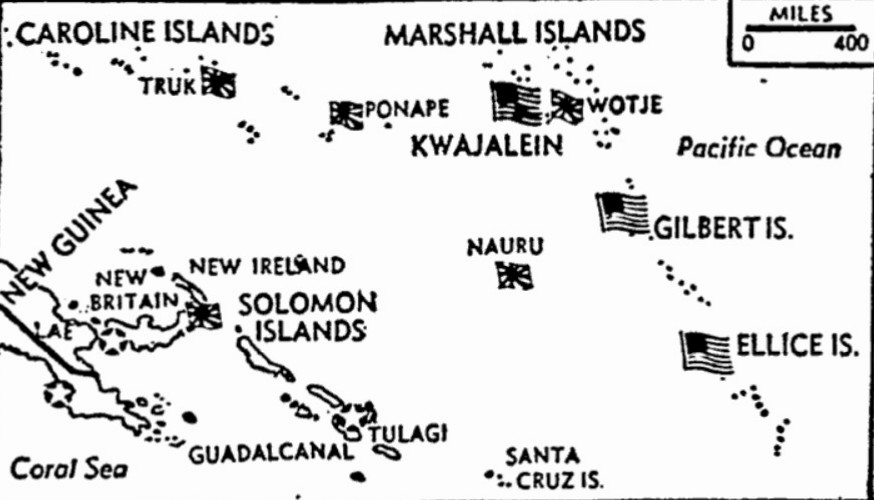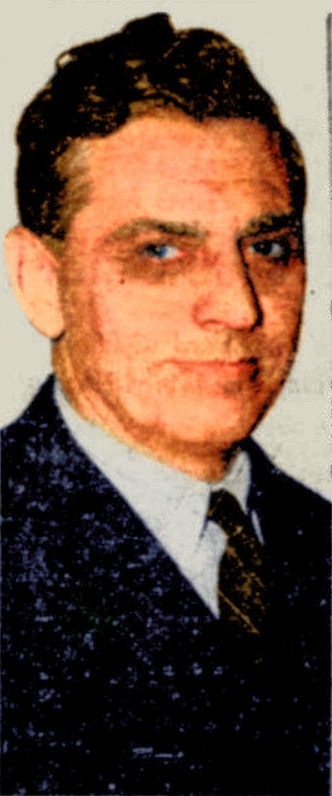Japs isolated in Marshalls
U.S. invasion fleet enters Kwajalein, main enemy base east of Truk
By William F. Tyree, United Press staff writer


Victory at Kwajalein Atoll for U.S. forces was almost complete today as Army troops mopped up the last Japs on Kwajalein Island, on the southern tip of the atoll. Marines wiped out the last Japs on Namur Island, in the north, and captured several nearby islets, including Edgigen and Gagan. Meanwhile, the U.S. invasion fleet sailed into Kwajalein Lagoon, formed by the reef of the atoll.
Pearl Harbor, Hawaii –
The biggest invasion fleet ever assembled in the Pacific has sailed into and occupied Kwajalein Lagoon, Japan’s main naval base east of Truk, a front dispatch disclosed today as U.S. Army troops mopped up the last battered enemy troops on Kwajalein Island.
RAdm. Richmond K. Turner, commander of the amphibious forces, ordered all troop transports and most of the supporting, warships into the lagoon – the world’s largest – in the heart of the Marshall Islands so that the surrounding reef would protect them against Jap submarines.
Leif Erickson, representing the combined Allied press on the joint expeditionary force flagship, said the ships entered the lagoon on the second day of the invasion Tuesday while Marines and Army troops were still battling desperately-resisting Japs at either end of the 66-mile-long Kwajalein Atoll.
Other islands cut off
The dispatch did not mention whether the vessels encountered any opposition, but it was presumed that the terrific preliminary bombardment had wrecked any Jap ships still in the lagoon and knocked out enemy coastal batteries.
Mr. Erickson indicated that the Americans might not bother to invade the other atolls in the Marshalls. Cut off from their main supply base at Kwajalein, the enemy garrisons may be left to starve, Mr. Erickson said.
Overruns airfield
A U.S. Army regiment has overrun the airfield on Kwajalein Island, the last airstrip in the atoll remaining in enemy hands, and overwhelmed a tank trap position to the east, Mr. Erickson reported.
Radio Tokyo broadcast an Imperial Headquarters communiqué early today, but it contained no mention of the Marshall Islands.
The 4th Marine Division under Maj. Gen. Harry Schmidt, completed the conquest of Namur Island, blasted by bombs and shells in probably the most concentrated bombardment in history, at the northeastern corner of the atoll at 1:00 p.m. (local time) Wednesday after wiping out the defenders in 24½ hours.
Losses small
The adjacent islands of Gagan, Edjell, Debuu and Edgigen were also overrun by the invaders, with overall U.S. losses in the northern part of the campaign totaling only 100 dead and 400 wounded.
On Kwajalein Island at the southern tip of the atoll, the Army 7th Infantry Division under Maj. Gen, Charles H. Corlett was reported making “satisfactory progress” with tanks, flamethrowers and possibly secret weapons never before employed in the Pacific, methodically annihilating the remnants of the trapped garrison.
A spokesman for Adm. Chester W. Nimitz, commander of the Pacific Fleet, announced yesterday that known enemy dead on Kwajalein Island up to Wednesday night were 1,250 of the estimated original garrison of 2,000, while U.S. casualties totaled 27 dead, nine missing and 190 wounded.
Japs counterattack
The Japs counterattacked on Kwajalein Tuesday night, but were thrown back and dispersed with heavy losses.
Kwajalein Island, 2½ miles long, was the main Jap base for the atoll of the same name and the enemy had massed a huge concentration of military stores in 250 large buildings in the northeastern corner, where the last defenders were holding out.
The record Allied air and sea bombardment preceding and accompanying the invasion of Japan’s principal Marshalls base was so paralyzing that not a single enemy plane had attacked the amphibious forces from the time they left their home port at least through Thursday, Mr. Erickson’s dispatch revealed. Not a ship was lost from any cause.
Cites lives saved
Adm. Turner told Mr. Erickson:
Our gains are important and they haven’t cost us much. Maybe we had too many ships for this job, but I prefer to do things that way. It was many lives saved for us, and it should be a discouragement to the Japs everywhere to know that when we hot, we really hit hard and for keeps.
The U.S. naval escort for the invasion fleet comprised the largest naval striking force every assembled on any ocean and included every type warship from the newest 16-inch gun battleships to submarines.
Attack other islands
Meanwhile, the U.S. 7th Air Force and Fleet Air Wing Two kept up their ceaseless pounding of other islands in the Marshall group, making at least five attacks Tuesday and Wednesday.
A special announcement said Army Liberators dropped nearly eight tons of bombs on Rongelap, 125 miles north of Kwajalein Atoll, Wednesday, while Dauntless dive bombers with a fighter escort placed more than 13 tons of explosives on the airdrome and gun emplacements at Mili. No enemy fighters were encountered and anti-aircraft fire was described as only moderate.
Bomb beached vessel
Navy search planes bombed a small beached vessel at Namur Atoll, just south off Kwajalein, and also dropped one ton of bombs each on Wotje and Taroa Tuesday.
The 7th Air Force alone was revealed to have dropped more than 1,750 tons of bombs ranging from 25-pound fragmentation missiles to half-ton atoll-busters on the Marshalls before the start of the invasion.
The bombings were supplemented with cannonading by new rapid-landing 75mm cannon mounted in Mitchell medium bombers. The Liberators were forced to fly up to 2,400 miles – equal to two roundtrips between London and Berlin – for their 680 preliminary sorties.
Jones: Japs almost driven insane by bombardment of island
By George E. Jones, United Press staff writer
Namur Island, Kwajalein, the Marshalls – (Feb. 3, delayed)
Scattered snipers and unseen enemy wounded remain on this shattered, stinking island, but the actual end of sustained combat came at 1:00 p.m. yesterday in a little corner near the northwest tip of Namur Island as the Marines pressed in for the kill.
Organized enemy resistance was ended, and even the toughened, battle-hardened Marines were disgusted with the task of wiping out Jap troops who hovered on the borderline of insanity as the result of the Allied bombardment and the ensuing hopeless retreat across the island.
U.S. casualties have been very moderate, although they include one of the most popular officers in the Marine Corps.
Only a few score Japs of the original force who garrisoned Namur and the adjoining island of Roi were left as a ring of Marine gunfire tightened about their defensive position, which was probably a command post.
Their fight was hopeless from the very beginning. It was a murderous bombardment, then an inevitable retreat in the face of superior Marine firepower. Light mobile artillery, flamethrowers and bazookas thundered and rocked against the crumbling concrete pillboxes and then the Japs were surrounded.
Most remained in hiding, awaiting the end which came quickly in most cases. Only a few tried to break the encirclement and they could not make it.
I was on that battlefield with Capt. Arthur Hanson of Washington when the staccato chatter of machine guns and the resonant thumps of Marine mortars died away.
For more than four hours, I had been dodging sniper bullets as I poked among the ruins, and the silence seemed unnatural.
In their two-day battle, the Japs resorted to a few of their favorite tactics. During the night, some crawled back into wrecked pillboxes and had to be killed yesterday morning.
Sergeant cleans up
The most ambitious maneuver of this kind involved a half-dozen riflemen who sneaked into a dugout and harassed rear echelons until an unidentified sergeant walked inside along with a Garand and killed every Jap.
Sgt. Archie Vale, 45, of Grand Junction, Colorado, was credited with destroying another nest of snipers. He shot three Japs and then tossed in a grenade.
He said:
They’d keep popping up and I threw more grenades. The tip of one officer’s saber kept showing above the shell hole where the Japs lay.
Sgt. Vale killed 13 Japs, including three officers.
Like Indian warfare
The Marines brought ashore a large assortment of heavy and fancy weapons past the wrecked beach defenses. The battle, however, became true French and Indian warfare – tree to tree, men flopping into the coral soil behind available protection when hidden enemy rifles and machine guns opened fire, then circling the flanking pocket of resistance and finally destroying it with grenades and bullets.
The effect of the bombardment can be appreciated only by seeing for yourself the destruction wrought on the islands of Roi and Namur, blockhouses terrifically battered, gun barrels of the coastal defenses twisted and shattered amidst debris and the dismembered bodies of their crews.
The entire island of Namur was transformed into an inferno. Neat rows of palm trees were mutilated and burned by shells and bombs. Tin-roofed barracks were crumpled and disintegrated. Sturdier buildings burned to their concrete framework.
Debris goes 3,000 feet high
The explosion of one blockhouse threw debris 3,000 feet into the air. As I picked myself from the ground, a chunk of concrete the size of my fist, brushed my arm, narrowly missing my typewriter.
Tons of stores and supplies are now pouring ashore, and the Marines who destroyed enemy resistance in 24½ hours are unloading cargo from scores of landing craft.
The crowded beaches greatly resemble Coney Island on a hot summer day. There is a display of newly-acquired loot – nearly every other man carries a bottle of Jap wine or beer. Other Marines captured officers’ swords, knives and insignia and stared in awe at pornographic pictures, of which the Japs seemed to have plenty.
Mostly the Marines are sleeping and eating, comparing experiences and wishing they could remove some of the rotting bodies from these islands.
Each death hard to take
They are also finding out who was killed or wounded. While U.S. casualties were very moderate, each one shot was hard to take.
They brought down the body of one of the most popular officers in the Marine Corps yesterday afternoon. He leaped into battle, throwing grenades and firing a rifle, standing upright in a field of fire. A machine-gun burst got him.
As his poncho-covered body came down a trail on a litter, one Marine told me:
He was standing up when he got it.
The Marine looked at the corpse and muttered, “Damn fool!”
There were tears in his eyes as he plodded on.





